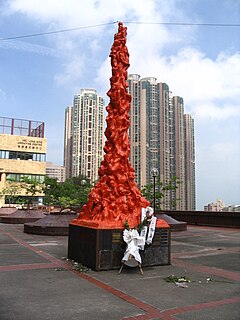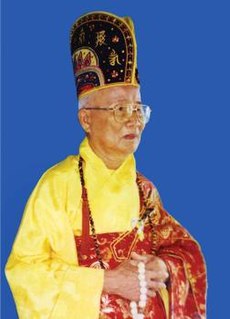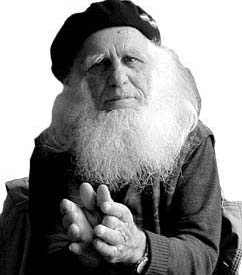
The first memorials to the victims of the September 11 attacks in 2001 began to take shape online, as hundreds of webmasters posted their own thoughts, links to the Red Cross and other rescue agencies, photos, and eyewitness accounts. Numerous online September 11 memorials began appearing a few hours after the attacks, although many of these memorials were only temporary. Around the world, U.S. embassies and consulates became makeshift memorials as people came out to pay their respects.
One World is the largest human rights film festival in the world, held annually in Prague and other 36 cities of the Czech Republic, with a selection later shown in Brussels and other countries. The festival highlights quality documentary films on social, political, environmental, media and human rights issues. One World presents over a 100 documentary films from all around the globe and organizes numerous Q&As with filmmakers and experts.

Nataša Kandić is a Serbian political writer, human rights activist and coordinator of the RECOM Reconciliation Network, founder and ex-executive director of the Humanitarian Law Center (HLC), an organization campaigning for human rights and reconciliation in the former Yugoslavia, focusing on the Serbian role in the conflict. It was formed in 1992. The HLC's research was integral to the war crimes prosecutions of the International Criminal Tribunal for the Former Yugoslavia (ICTY), particularly the "smoking gun" video linking Serbian military forces to the Srebrenica massacres. She has won numerous international awards for her human rights work. She is a figure of controversy in Serbia where she was the subject of a defamation lawsuit by former President of Serbia Tomislav Nikolić.

Human taxonomy is the classification of the human species within zoological taxonomy. The systematic genus, Homo, is designed to include both anatomically modern humans and extinct varieties of archaic humans. Current humans have been designated as subspecies Homo sapiens sapiens, differentiated, according to some, from the direct ancestor, Homo sapiens idaltu.

Pillar of Shame is a series of sculptures by Danish artist Jens Galschiøt memorialising the loss of life during specific events or caused by specific circumstances in history. Each sculpture is an eight-metre (26 ft) tall statue of bronze, copper or concrete.
Thích Quảng Độ was a Vietnamese Buddhist monk and scholar who was the patriarch of the Unified Buddhist Church of Vietnam (UBCV) from 2008 until his death. Since the execution of his master at the hands of the communist Viet Minh in his teenage years, Thích Quảng Độ had been involved in political activism, firstly against the anti-Buddhist policies of the Catholic President of South Vietnam Ngo Dinh Diem. After the fall of Saigon, the UBCV was banned by the communist government, and as one of the senior monks in the organisation, Thích Quảng Độ was at the forefront of the UBCV's defiance of the government, refusing to join the government-endorsed Vietnamese Buddhist Church. He was detained repeatedly by the communist authorities in the last 45 years of his life for his resistance and criticism of their policies, particularly his calls for multi-party democracy. During the Vietnam War period, he also served as a university academic in Buddhism, translated sutras and wrote books, notably a nine-volume Buddhist encyclopedia, and two-volume dictionary between Vietnamese and Sino-Vietnamese.

There have been several remembrances of the Mountain Meadows Massacre including commemorative observances, the building of monuments and markers, and the creation of associations and other groups to help promote the massacre's history and ensure protection of the massacre site and grave sites.

Homo homini lupus, or in its unabridged form Homo homini lupus est, is a Latin proverb meaning "A man is a wolf to another man," or more tersely "Man is wolf to man." It has meaning in reference to situations where people are known to have behaved in a way comparably in nature to a wolf. The wolf as a creature is thought, in this example, to have qualities of being predatory, cruel, inhuman i.e. more like an animal than civilized.

Thích Huyền Quang was a Vietnamese Buddhist monk, dissident and activist. At the time, he was the Patriarch of the Unified Buddhist Church of Vietnam, a currently banned organisation in his homeland. He was notable for his activism for human and religious rights in Vietnam.

Svetlana Alekseevna Gannushkina is a mathematician and human rights activist in Russia who was reported to have been a serious contender for the 2010 Nobel Peace Prize.
The Homo Homini Award is given annually by the Czech human rights organization People in Need to "an individual in recognition of a dedication to the promotion of human rights, democracy and non-violent solutions to political conflicts". The award is presented at the One World Film Festival, the world's largest human rights film festival.
The Viasna Human Rights Centre is a human rights organization based in Minsk, Belarus. The organization aims to provide financial and legal assistance to political prisoners and their families, and was founded in 1996 by activist Ales Bialatski in response to large-scale repression of demonstrations by the government of Alexander Lukashenko.

Gheorghe Briceag was a Moldovan human rights activist notable for his opposition to Soviet rule. In the 1940s, Briceag was given a ten-year sentence in the gulag for distributing anti-communist flyers; he was forced to work in coal mines for the length of his sentence. His prisoner number was "P169". After his release, he was sentenced to seven more years of exile. He later became a symbol of resistance to Soviet occupation of Moldova.

The Victims of Terrorist Attack on the Pentagon Memorial is a memorial over a group burial site at Arlington National Cemetery in the United States. It commemorates the victims of the attack on the Pentagon, which was struck by a Boeing 757 commercial airliner hijacked by five al-Qaeda terrorists on September 11, 2001, killing 184 people. The memorial specifically honors the five individuals for whom no identifiable remains were found. However, a portion of the remains of 25 other victims are buried at the site. The names of the 115 Pentagon employees and 10 contractors in the building, as well as the 53 passengers and six crew members aboard American Airlines Flight 77 are inscribed on the memorial.

Patio 29 is a common grave site in Santiago General Cemetery in Chile, where political prisoners, especially those who "disappeared" during the 1973 Chilean coup d'état, were buried anonymously. The mass grave, the largest of Augusto Pinochet's military government, was used for unannounced and unmarked burials in the 1970s until an anonymous tip alerted the public to its usage. With the return of democracy to Chile in 1990, an exhumation effort through 2006 recovered 126 bodies in 105 graves and identified three-quarters of the victims. A 2005 DNA test later reported widespread identification errors and a new identification database began in 2007. Exhumation authorities report that the site has been fully exhumed, a claim contested by which families of the victims.

The 7 July Memorial is a permanent memorial to the 52 victims of the 7 July 2005 London bombings. It is located on the east side of Hyde Park, between Lover's Walk and Park Lane, close to Curzon Gate and about 150 metres (490 ft) north of the monumental statue of Achilles.

The Kielce Ghetto was a Jewish World War II ghetto created in 1941 by the Schutzstaffel (SS) in the Polish city of Kielce in the south-western region of the Second Polish Republic, occupied by German forces from 4 September 1939. Before the Nazi invasion of Poland in 1939, Kielce was the capital of the Kielce Voivodeship. The Germans incorporated the city into Distrikt Radom of the semi-colonial General Government territory. The liquidation of the ghetto took place in August 1942, with over 21,000 victims deported to their deaths at the Treblinka extermination camp, and several thousands more shot, face-to-face.

The Mausoleum of the Martyrdom of Polish Villages in Michniów is a museum located in Michniów, in Świętokrzyskie Voivodeship, in Poland, constituting a branch of the Museum of the Kielce Village, commemorating the pacification actions in German-occupied Poland.
Marfa Rabkova is a Belarusian human rights activist and part of the Viasna Human Rights Centre. In 2020 she was arrested by the Belarusian authorities for her activism and sent to the pre-trial prison SIZO No. 1. In 2021 she was awarded the Homo Homini Award together with three other arrested Belarusian human rights activists.
Souad Nawfal is a Syrian Muslim schoolteacher and activist who became known for her protests against Bashar al-Assad and the Islamic State (ISIS) in Syria. She received the Homo Homini Award, a human rights award, in 2014.














